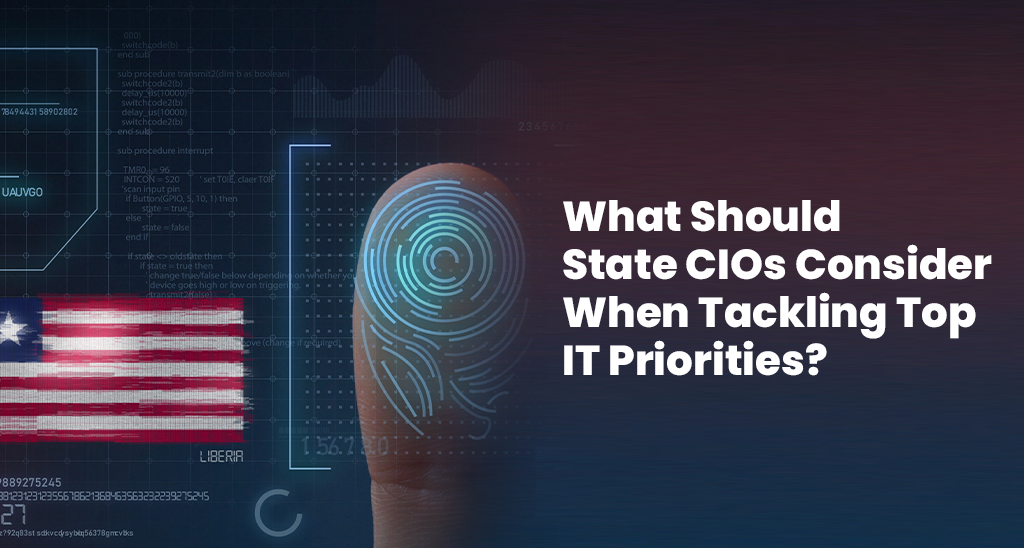What Should State CIOs Consider When Tackling Top IT Priorities?
As state governments continue to grow and evolve, their reliance on technology and IT infrastructure have increased substantially. State Chief Information Officers (CIOs) are at the forefront of this transformation, leading the charge in implementing new technologies and initiatives that improve government efficiency and service delivery.
However, CIOs face several challenges when tackling top IT priorities, from cybersecurity threats to limited budgets. This blog will discuss what state CIOs should consider when tackling top IT priorities.
Cybersecurity
One of the most critical priorities for state CIOs is cybersecurity. With an increasing number of cyber-attacks targeting government infrastructure, it is imperative that state governments take necessary measures to protect themselves. When tackling cybersecurity as a top IT priority, state CIOs should consider several factors, such as developing a comprehensive cybersecurity strategy, implementing a Zero Trust security model, and conducting regular vulnerability assessments and security audits. Additionally, they should ensure that all employees are well-trained in cybersecurity best practices and that they have access to the necessary resources and tools to maintain security.
Cloud Computing
Cloud computing has become more and more popular in recent years, providing state governments with access to on-demand computing services, storage, and other resources. When tackling cloud computing as a top IT priority, state CIOs should consider several factors, such as selecting the appropriate cloud services provider, ensuring that data is stored securely, and monitoring the performance of cloud-based systems. Additionally, they should ensure that all employees are well-trained in cloud computing best practices, such as data management and security, to ensure that sensitive data is protected.
Data Management
The effective management of data is critical for state governments to deliver efficient and effective services. When tackling data management as a top IT priority, state CIOs should consider several factors, such as ensuring data quality, maintaining data integrity, and safeguarding sensitive data. Additionally, they should develop clear policies and procedures for data management, including data classification, data retention, and data access.
Digital Transformation
Digital transformation involves using technology to streamline processes, improve services, and enhance the overall citizen experience. When tackling digital transformation as a top IT priority, state CIOs should consider several factors, such as developing a digital transformation strategy, identifying areas of the government that can benefit from digital transformation, and ensuring that all employees are well-trained in the use of new technology. Additionally, they should prioritize investments in emerging technologies such as machine learning, artificial intelligence, and the Internet of Things (IoT) to further enhance service delivery.
How Hiring Mistakes Impact Your Business?
Legacy Systems Modernization
Legacy systems, which are outdated technology systems that are no longer supported or maintained, can pose significant challenges for state governments. When tackling legacy systems modernization as a top IT priority, state CIOs should consider several factors, such as identifying critical systems that need modernization, developing a modernization strategy, and ensuring that modernized systems are secure and fully functional. Additionally, they should prioritize investments in modernizing legacy systems that are essential for delivering services to citizens.
Limited Budgets
Limited budgets can pose significant challenges for state governments, especially when tackling top IT priorities. When facing limited budgets, state CIOs should consider several factors, such as prioritizing investments in technology that deliver the most significant benefits, developing partnerships with other government entities, and leveraging open-source software to reduce costs. Additionally, they should consider alternative financing options, such as public-private partnerships, to supplement their IT budgets.
To successfully tackle these priorities, state CIOs should consider partnering with Infojini, a staffing and recruiting company that specializes in providing staff augmentation, technology consulting, and project management services to its clients in various industries.
Infojini Staffing can help state CIOs tackle their top IT priorities by helping state CIOs identify and recruit qualified and experienced IT professionals to augment their current staff to fill skills gaps and provide additional resources to tackle priority projects.
Conclusion
In conclusion, state CIOs play a crucial role in enabling digital transformation, modernizing legacy systems, and ensuring that the government delivers efficient and effective services to citizens. By developing a comprehensive strategy and prioritizing investments in emerging technologies, state CIOs can ensure that their IT initiatives deliver the most significant benefits to the government and its citizens.
Overall, partnering with Infojini can help state CIOs tackle their top IT priorities by providing qualified and experienced IT professionals, technology consulting, project management, and training and development services.
A Guide to Contingent Workforce Management
This report covers all you need to know about
using talent intelligence to transform your
workforce strategy.
Related Posts
Subscribe For Updates
Categories
- Accountant
- AI
- Automation
- Awards and Recognitions
- Blue Collar Staffing
- Burnouts
- Campus Recruiting
- Cloud
- Co-Ops agreements
- Company Culture
- Compliance
- contingent workforce
- Contingent Workforce
- COVID-19
- Cyber Security Staffing
- Data Strategy
- Digital Transformation
- direct sourcing
- Distributed Workforce
- Diversity
- Diversity & Inclusion
- Economy
- Events & Conferences
- fleet industry
- Gig Economy
- Girls in Tech
- Global Talent Research and Staffing
- Government
- Healthcare
- Healthcare Staffing
- Hiring Process
- Hiring Trends
- Home Helathcare
- HR
- HR Practices
- HR Tech
- IT
- Labor Shortages
- Life Science
- Local Governments
- News
- Nursing
- Payroll Staffing
- Public Sectors
- Recruiting
- Remote Work
- Skill Gap
- SMB Hiring
- Snowflake
- Staffing
- Staffing Augmentation
- Staffing Challenges
- Talent ROI
- Tech Staffing
- Technology
- Tips & tricks
- Total Talent Management
- UI/UX Design
- Uncategorized
- Veteran Staffing
- Veterans Hiring
- Veterans Hiring
- Workforce Management
Recent Posts
- Automation in Recruiting: From Chatbots to Predictive Screening
- Gig Economy Expansion: The Impact on Talent Pools and Business Models
- Skills-Based Hiring: Why Credentials Alone Don’t Cut It in 2025
- Procurement 3.0: AI & Intelligent Automation in 2025
- Q3 Is Here: Is Your Contingent Workforce Strategy Falling Behind?
Newsletter
Archive
- September 2025
- August 2025
- June 2025
- April 2025
- March 2025
- December 2024
- November 2024
- October 2024
- September 2024
- August 2024
- July 2024
- June 2024
- May 2024
- April 2024
- March 2024
- February 2024
- January 2024
- December 2023
- November 2023
- October 2023
- September 2023
- August 2023
- July 2023
- June 2023
- May 2023
- April 2023
- March 2023
- February 2023
- December 2022
- November 2022
- October 2022
- September 2022
- August 2022
- July 2022
- June 2022
- November 2021
- October 2021
- September 2021
- August 2021
- July 2021
- June 2021
- May 2021
- April 2021
- March 2021
- February 2021
- January 2021
- December 2020
- November 2020
- October 2020
- September 2020
- August 2020
- July 2020
- June 2020
- May 2020
- April 2020
- March 2020
- February 2020
- January 2020
- December 2019
- November 2019
- October 2019
- September 2019
- August 2019
- July 2019
- June 2019
- May 2019
- January 2019
- December 2018
- November 2018
- October 2018
- September 2018
- August 2018
- July 2018
- June 2018
- May 2018
- April 2018
- March 2018
- February 2018
- January 2018
- December 2017
- November 2017
- October 2017
- September 2017
- August 2017
- July 2017
- June 2017
- May 2017
- November 2016
- October 2016




